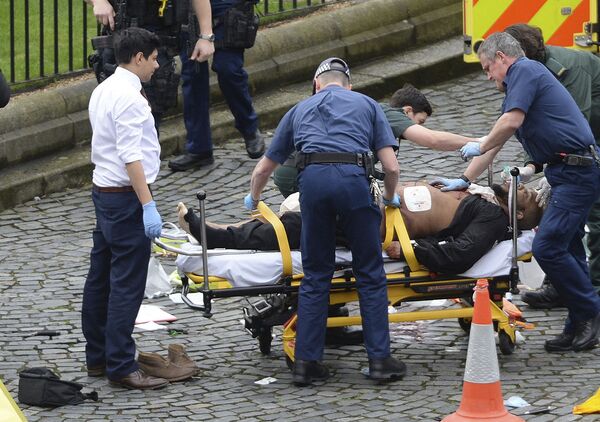Initially arrested on suspicion of terror offences, then attempted murder, the Sudanese immigrant, who resided in the Sparkhill area of Birmingham, was a former accountancy student at Coventry University, but dropped out after less than a year in May.
While Khater is still refusing to cooperate with investigators, and little has been disclosed about him so far, officials have indicated the attacker was not known to security services of any stripe prior to the attack, a notable feature of the incident.
State surveillance of suspects prior to attacks, and missed opportunities to prevent such events, are a recurring theme of major terrorist incidents in Western countries. In the case of the June 2017 London Bridge attacks, which claimed the lives of eight civilians, it has emerged security agents surveilled the trio as they loaded a van used in the attack before departing to their fateful destination.

Troubling Parallels
Nonetheless, Khater's attempted strike was not without recent parallel — perhaps most obviously, the March 22 2017 terror attack outside the Palace of Westminster, less than a fifth of a mile away from where August 14's violence unfolded.
Khalid Masood, 52, drove a car into pedestrians on the pavement along the south side of Westminster Bridge and Bridge Street, injuring over 50 and killing five. He then crashed the vehicle into the perimeter fence of Westminster Palace and ran into New Palace Yard, in an apparent attempt to enter parliament. En route, he fatally stabbed a police officer, before being shot by an armed police officer and dying at the scene.

Subsequent investigation by both media and authorities revealed Masood to be a heavy cocaine user with an extensive history of violence. Convictions for public order offences stretched back to 1983 — but in 2000, he was sentenced to two years in prison for grievous bodily harm after a knife attack in a bar in Sussex. Three years later, he received a further six months' incarceration for possession of an offensive weapon following another knife attack in Sussex. It was while in prison he converted to Islam, and he subsequently made several visits to Saudi Arabia.
Like other terrorists before and since, Masood was well-known to security services. In 2010, he was a "peripheral figure" in an MI5 investigation into a group of Islamists later convicted of plotting to bomb a Territorial Army base in Luton — although following a risk assessment, MI5 decided he didn't pose a threat.
However, between 2012 — 2016, Masood was a person of interest in MI5 investigations as a contact of individuals linked to UK-based salafist organization Al-Muhajiroun.
Some critical voices have questioned how to he seemingly arrived with such precision at the exact moment the Carriage Gate to the South of the parliamentary estate was not only wide open but merely manned by unarmed uniformed police officers, rather than armed specialists. Had it not been for the miraculous presence at the scene of then-Defense Secretary Michael Fallon's armed bodyguard, Masood would've likely enacted far greater carnage than he ultimately managed.
Point of Origin
In many ways, Masood was an atypical jihadist, given most are under 30. However, like Khater he resided in Birmingham — an area of the UK that has become closely associated with Islamic extremism. The city, Britain's second-largest, was allegedly the birthplace of the UK's first suicide bomber, where the country's first al-Qaeda plot was hatched, and was also home to one of the financiers of the 9/11 atrocity.
Masood rented the vehicle used in his attack from Enterprise's Birmingham branch, and the days following the incident saw police carry out a series of raids across the city — four arrests, out of eight nationwide, were made there.
Moreover, a study in 2017 estimated one in 10 of all those linked to Islamist terrorism in Britain and abroad — 26 in total — hailed from just five council wards in Birmingham; Bordesley Green, Hodge Hill, Sparkbrook, Springfield, and Washwood Heath. In all, 39 convicted terrorists have hailed from Birmingham, more than West Yorkshire, Greater Manchester and Lancashire combined, out of a Muslim population of 234,000.

Likewise, Rashid Rauf, a ringleader of a plot to blow up transatlantic airliners in 2006, was a Birmingham resident. He was arrested in Pakistan in December that year but charges against him were eventually reduced to forgery and possession of explosives. He subsequently escaped from prison, and is said to have been killed in a 2008 drone strike. American officials have claimed Rauf he was protected — and may have been allowed to flee custody — by extremist elements within Pakistani intelligence.

The prevalence of thought in the city is often said to result from extensive infiltration of both state and local Islamic education resources by extremist elements. Birmingham has been accused of being the center of 'peration trojan horse,' a plot by organized Islamists to infiltrate and take over state education structures.
Whether a genuine strategy or not, the infection of mainstream Islamic institutions in the UK by extremist ideology has long been known by authorities and the public alike, but typically only in the aftermath of major terrorist attacks is it widely acknowledged.

For instance, in 2010 an investigation found around 40 Islamic religious schools operating in Britain used anti-Semitic textbooks to teach children as young as six Jews descend from "monkeys" and "pigs" — and Zionists are plotting to take over the world. One textbook asked children to itemize the "reprehensible" qualities of Jews — another taught the penalty for sodomy is execution, and outlined differing perspectives as to whether death should be meted out via stoning, immolation or throwing offenders off a cliff.



